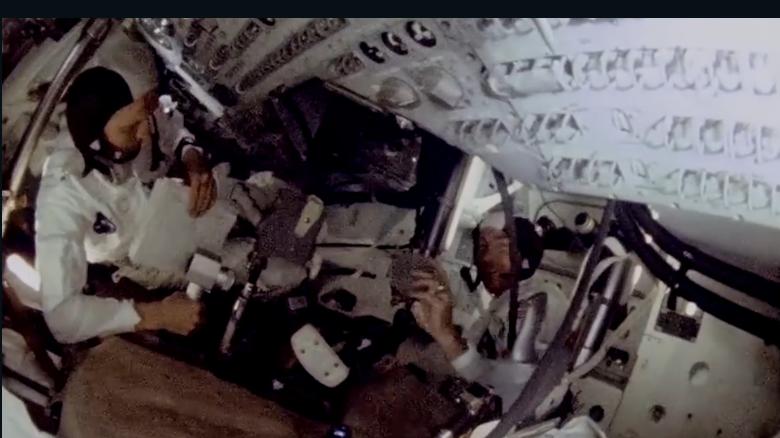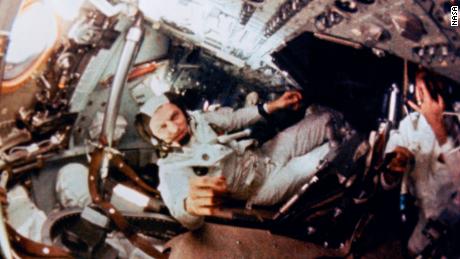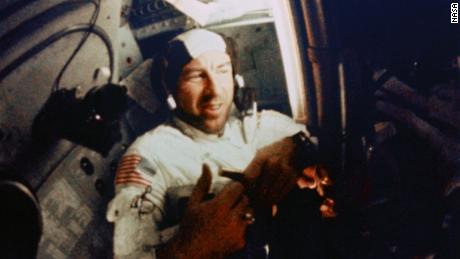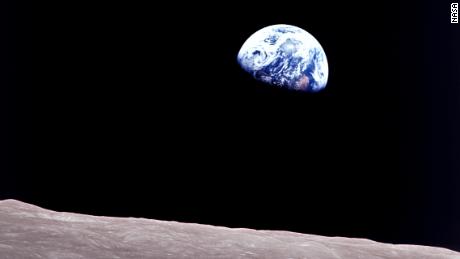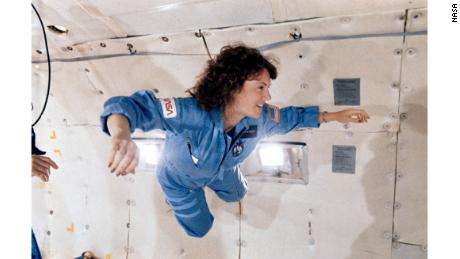It's been 50 years since Apollo 8 united a fractured world
Updated 2225 GMT (0625 HKT) December 22, 2018
(CNN)They were just three men. But their peaceful message was seen by a billion people. And the timing couldn't have been better.
50 years ago, Apollo 8 was credited with "saving" a terrible year. In 1968 the world was a mess. America was politically divided. Heroes Martin Luther King Jr. and Robert F. Kennedy had been gunned down by assassins. More US troops were dying than ever in the Vietnam War. People were questioning authority and resisting the status quo.
By Christmas Eve, the Apollo 8 crew ŌĆö Frank Borman, Bill Anders and Jim Lovell ŌĆö had made history. For the first time, humans had traveled to another world.
"This is Apollo 8 coming to you live from the moon," Borman announced after activating a small hand-held TV camera. The crew took a few minutes to show viewers what the moon looked like from about 70 miles above the surface.
NASA had told the astronauts they should say something appropriate during the broadcast. But few knew what they would choose to say. An estimated 1 billion people in 64 countries were tuning in.
Borman continued: "We are now approaching lunar sunrise and for all the people back on Earth, the crew of Apollo 8 has a message that we would like to send to you. 'In the beginning, God created heaven and Earth. ...'" Each astronaut read a few lines from the Bible's Book of Genesis.
Finally Borman said, "And from the crew of Apollo 8, we close with good night, good luck, a merry Christmas and God bless all of you, all of you on the good Earth."
It was a shared moment in history.
For America and the world, the message of peace became a welcome bright spot after a series of dark tragedies. So much so, that five months later the US Postal Service issued a stamp showing the Earth rising above the moon's horizon with the words, "In the beginning God..."
In an interview with CNN this month, Lovell recalled his adventure as Apollo 8's navigator. "To me, it was a mini Lewis and Clark expedition," Lovell said. "We were going someplace new to observe the far side of the moon, which had never been seen before."
At one point Lovell extended his arm toward the window of the spaceship. The Earth was so small that he could cover it with his thumb.
"I realized that behind my thumb, there were about (3.5 billion) people and everything I ever knew," said Lovell, now age 90. "I suddenly got a different feeling about life in general and my position in it."
Pioneers and heroes
In the late 1960s young people were wondering where America's heroes had gone. For many, the Apollo program provided an answer.
Like my friends and family, I was among the 1 billion people watching the astronauts on TV ŌĆö sitting cross-legged on the floor way too close to the family Magnavox. A generation of kids ŌĆö many of us hopped up on Kool-Aid and obsessed with our Major Matt Mason astronaut action figures ŌĆö would be transformed by the imagination and accomplishments of Apollo.
We hung on the astronauts' every word during each live TV broadcast. We learned NASA's geeky acronyms for parts of the spacecraft, like CSM (command/service module), LM (pronounced "Lem," for the lunar module) and the SPS (service propulsion system). Sometimes we still couldn't really wrap our minds around the fact that these guys were traveling to the moon -- almost a quarter-million miles away.
Apollo inspired young people who went on to change the world, like Microsoft co-founders Bill Gates and Paul Allen, Google co-founder Sergey Brin and Apple co-founder Steve Jobs. Also fired up by Apollo were two guys named Jeff Bezos and Elon Musk, who of course went on to start their own aerospace companies. Bezos remembers being 5 and watching Neil Armstrong take the first human steps on the moon, the Seattle Times reported, which spurred the entrepreneur to embrace "this idea of science, engineering, technology and exploration."
Of course, the crew of Apollo 11 was the first to land on the moon, but Apollo 8's firsts were arguably more impressive. They were the first humans to:
- leave Earth's gravity
- orbit the moon and see its far side
- observe "Earthrise" above the moon's horizon
Their principal task was to test the spacecraft and photograph the surface to find landing spots for Apollo 11.
There was a lot of risk. In fact, the mission was full of unknowns and potential disasters: If Apollo 8's engine hadn't ignited, the crew might have been stranded in lunar orbit. If the crew had fired the engine too long or not long enough, they might have crashed into the moon or been lost in space.
Bonding over shared tragedy
Apollo 8's success made heroes of the crew and paved the way for eight more manned moonshots. All three men are alive today to share their adventure. In fact, Lovell returned to space as commander of Apollo 13 -- the mission that entered our collective imagination in the film starring Tom Hanks as Lovell. Sadly, not all astronauts survived the dangers of space travel.
Future space missions would create other shared moments against the backdrop of space. But some of those moments turned out to be painful lessons proving that exploration comes with deadly risks.
In 1986, children in classrooms around the nation watched the liftoff of space shuttle Challenger ŌĆö excited to see a teacher join a mission. Teacher Christa McAuliffe was planning to hold televised classes from orbit. The orbiter exploded shortly after liftoff ŌĆö killing McAuliffe and all six of her crewmates.
That evening, President Ronald Reagan consoled the nation during a TV address, saying, "It's all part of the process of exploration and discovery. It's all part of taking a chance and expanding man's horizons. The future doesn't belong to the fainthearted; it belongs to the brave. The Challenger crew was pulling us into the future, and we'll continue to follow them."
There were other shared moments in space. In 2003, another seven astronauts died during re-entry aboard the space shuttle Columbia.
President George W. Bush reminded America that:
"In an age when space flight has come to seem almost routine, it is easy to overlook the dangers of travel by rocket. ... These astronauts knew the dangers, and they faced them willingly, knowing they had a high and noble purpose in life. Because of their courage and daring and idealism, we will miss them all the more."
After Apollo ended in 1972 and the space shuttles were retired in 2011, there were fewer NASA missions that captured the world's imagination on a large scale.
But last year, the sun and the moon created a fascinating shared moment in space, when they performed a rare solar eclipse -- bringing people together to witness the celestial event of a lifetime.
'We've only scratched the surface'
New missions to the moon and Mars are in the works.
Musk and his SpaceX company have plans to send an unmanned rocket to Mars as soon as 2022, followed by manned missions as early as "around 2025," according to Musk.
NASA has announced an ambitious $10.5 billion plan to return humans to the moon as early as 2023, followed by human missions to Mars. (The Apollo program cost about $25 billion from 1962-1972, which equals about $150 billion in today's dollars.)
Lovell thinks humans should return to the moon. "We've only scratched the surface of exploring the moon and what it could offer us," he said. Once humans develop the rockets and other infrastructure to return to the moon, then the technology "could be expanded to go to Mars."
But Lovell added, "I think it's going to be a long time before anybody goes to Mars."
Nonetheless, the future seems bright for more historic moments in space.
If they happen, chances are good that future astronauts will be able to share those moments with the rest of us here on Earth.
